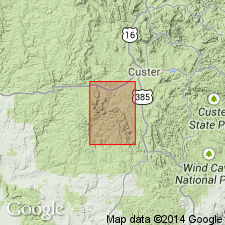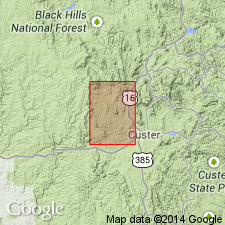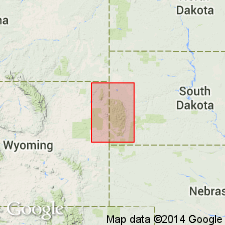
- Usage in publication:
-
- Bugtown formation*
- Modifications:
-
- Original reference
- Dominant lithology:
-
- Schist
- AAPG geologic province:
-
- Powder River basin
Summary:
Pg. 203, 204-207, pl. 21. Bugtown Formation. Oldest of metamorphic rocks in Fourmile quadrangle, Custer Co., southwestern South Dakota. Consists predominantly of quartz-mica schist, derived from graywacke and impure sandstone. Exposed thickness about 1,500 feet; estimated thickness 4,000 feet. Lower contact not exposed within limits of quadrangle; contact tentatively placed between massive quartz-mica schist typical of the Bugtown and an unnamed garnetiferous schist that lies to northeast. Underlies Crow formation (new). Age is Precambrian.
Named from Bugtown Gulch, [in secs. 12, 13, T. 3 S., R. 3 E.], Berne quadrangle, Custer Co., southwestern SD, which adjoins Fourmile quadrangle on north. Bugtown Gulch crosses well-exposed section of formation.
Source: US geologic names lexicon (USGS Bull. 1350, p. 100).

- Usage in publication:
-
- Bugtown Formation*
- Modifications:
-
- Revised
- Dominant lithology:
-
- Schist
- Iron-formation
- AAPG geologic province:
-
- Midcontinent region
Summary:
Originally (Redden, 1963, USGS PP 297-D) lower contact placed where massive quartz-mica-feldspar schists of Bugtown are in contact with unnamed garnetiferous schists. Is redefined [revised] to include the garnetiferous schists and quartz-mica-feldspar schists and other rock types. The Bugtown-Loues (new name applied in this chapter) contact placed at first appearance of massive quartz-mica-feldspar schists above dominantly thin-bedded micaceous schists of Loues. Type section of revised Precambrian Bugtown is along North Georgetown Gulch and northeastward to Atlantic Hill, SD, in Midcontinent region. Underlies Crow Formation.
Source: GNU records (USGS DDS-6; Denver GNULEX).

- Usage in publication:
-
- Bugtown Formation*
- Modifications:
-
- Age modified
- AAPG geologic province:
-
- Powder River basin
Summary:
Mapped as part Early Proterozoic unit Xgw (Pl. 1) west of the Grand Junction fault, Berne quad, Custer Co, SD in the Midcontinent region. Geologic map.
Source: GNU records (USGS DDS-6; Denver GNULEX).
For more information, please contact Nancy Stamm, Geologic Names Committee Secretary.
Asterisk (*) indicates published by U.S. Geological Survey authors.
"No current usage" (†) implies that a name has been abandoned or has fallen into disuse. Former usage and, if known, replacement name given in parentheses ( ).
Slash (/) indicates name conflicts with nomenclatural guidelines (CSN, 1933; ACSN, 1961, 1970; NACSN, 1983, 2005, 2021). May be explained within brackets ([ ]).

